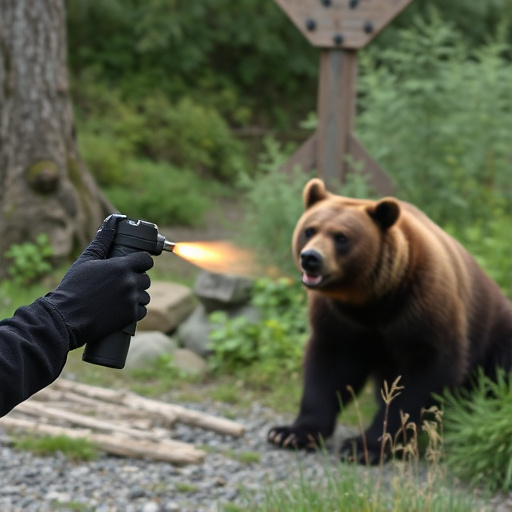Bear spray, an essential tool against aggressive bears, requires careful storage to maintain its effectiveness. Unlike common belief, it doesn't freeze solid at low temps but thickens, reducing range. Ideal storage conditions are cool (50-70°F or 10-21°C), dry, and away from direct sunlight, heat sources, and potential damage. Properly stored bear spray can prevent 'freezing' issues, ensuring optimal performance when facing bear threats, alongside correct application techniques practiced in controlled settings.
In the great outdoors, encountering wildlife can be an unforgettable experience, but it’s crucial to approach these meetings with caution, especially when facing bears. Bear spray, a popular defense mechanism, offers a non-lethal way to deter aggressive encounters. This article guides you through the essentials of bear spray protection. We’ll explore its composition, storage best practices, and safety tips for responsible use during unexpected wildlife interactions, ensuring your peace of mind in bear country. Learn how to prepare and respond effectively, considering even the concern of bear spray freezing in storage.
- Understanding Bear Spray: Composition and Functionality
- Storage Considerations: Ensuring Effectiveness of Bear Spray
- Safety Tips: Using Bear Spray Responsibly in Encounters
Understanding Bear Spray: Composition and Functionality
Bear spray, also known as bear deterrent or pepper spray, is a specialized repellent designed to protect individuals from aggressive bears during encounters in the wild. Its primary composition includes capsaicin, the active ingredient found in chili peppers, mixed with water and other additives to enhance its effectiveness. When used correctly, bear spray creates an irritant barrier, temporarily blinding and disorienting the bear, allowing the user to escape or retreat safely.
The functionality of bear spray relies on its ability to freeze at low temperatures, creating a mist that can reach up to 30 feet (9 meters). However, concerns often arise about its stability in storage, especially in colder climates. Contrary to some beliefs, bear spray does not necessarily freeze solid; instead, it becomes thick and may reduce in range. Proper storage is key to maintaining its effectiveness. It should be kept in a cool, dry place, ideally above freezing levels, to ensure optimal performance when needed.
Storage Considerations: Ensuring Effectiveness of Bear Spray
When storing bear spray, it’s crucial to consider environmental factors that can affect its effectiveness. Extreme temperatures, both hot and cold, can impact the spray’s performance. While it’s a common concern that bear spray might freeze in cold climates, it’s actually more about preventing it from becoming too thick or solidifying. In very warm conditions, the spray may lose its potency as certain components evaporate faster than others.
To maintain optimal effectiveness, store your bear spray in a cool, dry place with temperatures between 50°F and 70°F (10°C to 21°C). Avoid leaving it in direct sunlight or near heat sources. Ensure the container is sealed properly and check for any signs of damage or leakage before each use. Following these storage considerations will help guarantee that your bear spray remains reliable when you need it most during a wildlife encounter.
Safety Tips: Using Bear Spray Responsibly in Encounters
When it comes to safety during wildlife encounters, especially with bears, many outdoor enthusiasts turn to bear spray as a crucial defense mechanism. However, proper usage goes beyond simply carrying the canister; responsible handling is key to ensuring its effectiveness. One important aspect often overlooked is storage and the potential for freezing conditions. Bear spray can indeed freeze in cold environments, rendering it useless if not properly protected. It’s essential to keep canisters inside vehicles or warm areas when not in use to prevent this from happening.
To maximize the safety provided by bear spray, users should familiarize themselves with application techniques. Practice makes perfect; ensure you know the range and wind conditions for optimal results. Remember, it’s best to avoid encounters altogether through noise-making devices or careful trail choices, but if a bear approaches, using bear spray responsibly can be a life-saving measure.
Bear spray is a valuable tool for protecting yourself during unexpected wildlife encounters, but proper storage and usage are key. Understanding its composition, knowing how to store it effectively, and practicing safe usage can ensure its reliability when you need it most. Remember, while bear spray can be a game-changer in dangerous situations, it’s just one component of a comprehensive approach to outdoor safety, including awareness, noise making, and distance maintenance. In terms of storage concerns, the issue of freezing is real; understanding the environmental conditions that might cause it to freeze is essential for keeping it effective. By following these guidelines, you can maximize the potential of your bear spray while minimizing risks, thereby enhancing your overall outdoor experience.
